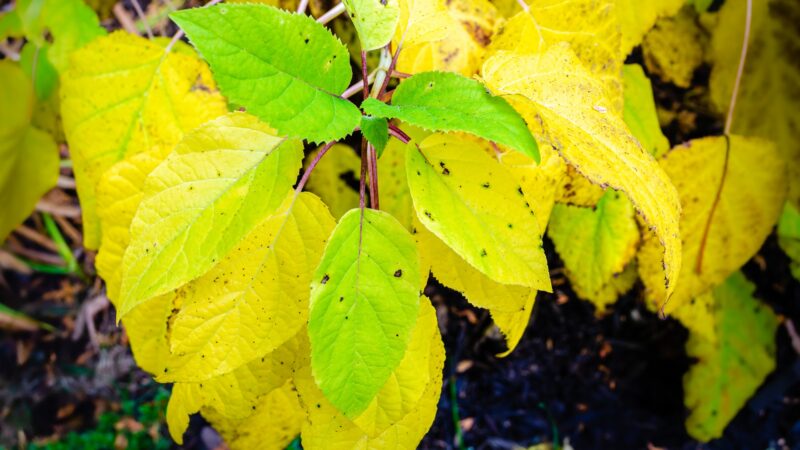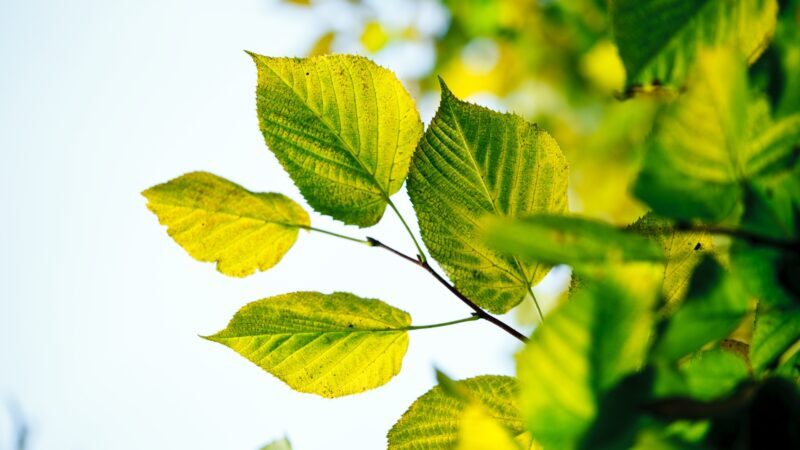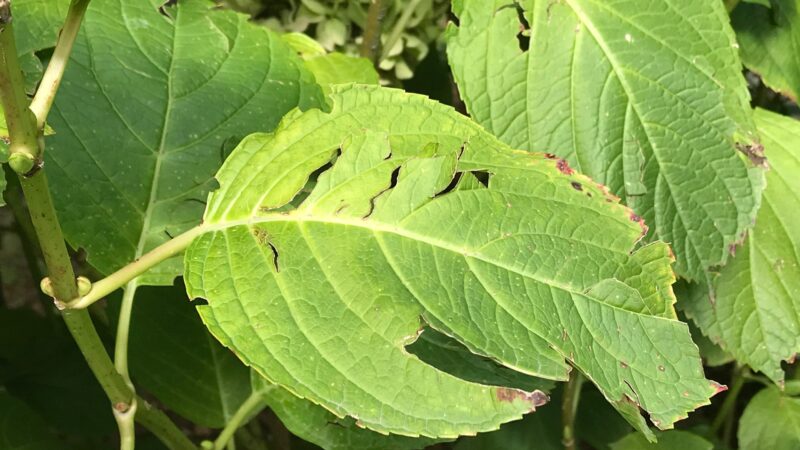Hydrangeas are stunning. With its dome-shaped cluster of flowers with pastel-colored petals, there’s no denying this plant is quite a beauty. It also has thick green foliage that turns a lovely red color during the autumn.
With that said, it’s uncommon for hydrangea leaves to turn yellow. More often than not, yellowing leaves are a cause for concern.
Hydrangea leaves turn yellow due to overwatering, underwatering, diseases, improper soil pH levels, iron, magnesium, and nitrogen deficiency, root issues, sudden temperature changes, and wrong lighting conditions.
But identifying these ten causes is not enough. You should also learn how to make the necessary remedies to help bring your hydrangea back to its best condition.
Is It Normal for Hydrangea Leaves to Turn Yellow?

It’s not normal for hydrangea leaves to turn yellow. During the autumn season when leaves naturally fall off of plants, hydrangea leaves turn red instead of yellow. Thus, it cannot be said that the presence of yellow leaves is merely part of its natural growth.
Usually, having yellow leaves on your hydrangea means that there is an underlying condition that needs your immediate attention. Some common causes may either be poor nutrition, disease or infection, or the plant is not getting enough water.
But regardless of the cause, know that you should treat it as soon as possible – otherwise, it may lead to your plant’s death.
Why Are My Hydrangea Leaves Turning Yellow?

Overwatering
One of the most common causes of yellow leaves on hydrangea plants is overwatering. While this plant loves deep watering every week, it may suffer from being overwatered if it is given too much water.
Unfortunately, an overwatered hydrangea will have yellow and mushy leaves, and that makes it quite unsightly. Not only that but being overwatered exposes your hydrangea to moist-loving fungi and bacteria that can cause diseases.
- Causes: Overwatering may be caused by giving your hydrangea more water than it can handle. Also, this may be due to poor-draining soil and a pot that is already clogged.
- Remedies: Fortunately, it is possible to remedy an overwatered hydrangea. If you noticed the overwatering early on, you may simply place it in an area where it can get direct sunlight to help dry out the soil faster.
However, if it has already led to soaked roots, the best option is to uproot the plant and allow it to dry overnight. Then, transfer it into a new pot filled with well-draining soil. Once re-potted, you may proceed to give it a deep watering once a week until it has recovered.
Underwatering
Hydrangeas love being watered. On average, a healthy hydrangea needs to be watered three times per week. Aside from keeping them hydrated, frequent watering also supports their healthy root growth.
Thus, it goes without saying that if your hydrangeas do not get enough water, they will become dehydrated. Aside from leaves turning yellow, their leaves will also become dry and brittle.
This is because the plant absorbs the remaining moisture content in its leaves and stems. Unfortunately, when it becomes underwatered for too long, it will ultimately lead to the plant’s demise.
- Causes: The plant is not getting the right amount of water that it needs.
- Remedies: When the plant is not getting enough water, then the remedy is to give it more water than you usually would. Make sure that the roots will also become soaked so that they can absorb the moisture from the soil. The key here is to water the plant until the water seeps through the drainage holes of the pot.
Diseases
Like all plants, hydrangeas are also susceptible to diseases. The most common diseases faced by hydrangeas include the Hydrangea Mosaic Virus and the Ringspot Virus. Aside from the leaves turning yellow, these diseases may also cause dark-colored spots on the leaves which makes them look distressed.
- Causes: Diseases may be caused by fungal growth due to the excess moisture surrounding the plant, or by contamination caused by dirty gardening tools.
- Remedy: In most cases, these diseases are caused by fungi, so the best remedy is to spray your plant with a fungicide like the BioAdvanced 3-in-1 Insect Disease and Mite Control. Not only will this stop the spread of fungi, but it will also prevent other disease-causing bacteria and insects from feasting on your hydrangea.
- 3-in-1 FORMULA: For use on roses, flowers, shrubs and trees to...
- COVERAGE AREA: Treats up to 192 roses with outdoor bug spray
- INSECT KILLER: Insect spray kills Aphids, Spider Mites, adult...
- RAINPROOF PROTECTION: Fungicide for plants offers rainproof...
- DISEASE CONTROL: Plant fungicide controls Black Spot, Powdery...
Also, to prevent these diseases from taking over your plants, it’s best to make sure that your gardening tools are always clean and sterilized before using them.
Improper soil pH levels
To thrive, hydrangeas prefer soil that’s slightly acidic. Its ideal range is between pH levels of 5.5 to 6.5. If the soil is more alkaline, it may not grow as well since it cannot absorb as many nutrients from the soil. This is also because the acidity of the soil helps break down the minerals to help the plants absorb them faster.
- Causes: The pH levels in the soil may have changed due to recent flooding, or the potted soil has been watered down frequently.
- Remedies: The best remedy to alkaline soil is to add an acidifier to the soil. The Down to Earth All Natural Acid Mix Fertilizer is a good option to consider, especially since it also contains nutrients that will benefit your hydrangeas. Then, water your hydrangea like usual to help it during its recovery period.
- A Natural fertilizer blended especially for acid lovers such as...
- To encourage lush flowers and fruit, apply Acid Mix in early...
- Fall Applications can help promote root growth and boost...
- All-Natural Ingredients: Made from organic, sustainably sourced...
- Slow-Release Formula: The slow-release nature ensures a steady...
Iron Deficiency
Hydrangeas rely heavily on iron to thrive. With that said, iron deficiency is one of the most common problems that hydrangeas face. And when a hydrangea is suffering from iron deficiency, its leaves turn yellow with visible green veins.
- Causes: The soil does not have enough iron content.
- Remedies: The best remedy for a plant that’s suffering from iron deficiency is to feed it with a plant supplement that’s rich in iron. A good example is the Southern Ag Iron Granules, which can be mixed into the soil for easier plant absorption.
- No mixing/ No spraying - use as a granular fertilizer
- Correct Iron deficiency in acid loving & tropical plants
- Acidifies soil, lowers pH, and corrects high alkalinity
Magnesium Deficiency
Aside from iron deficiency, hydrangeas are also known to suffer from magnesium deficiency. Similar to iron deficiency, this condition causes hydrangea leaves to turn yellow, except for the veins that remain green.
- Causes: The soil does not have enough magnesium for the plant to absorb.
- Remedies: To fight magnesium deficiency, you must feed your plant with a food supplement that’s rich in magnesium, like the Botanicare Cal-Mag Plus. But before feeding your plant with any food supplement, make sure to read the label for the proper dosage so as not to overfeed your hydrangeas.
- Great for Hydroponics
- Great for Soil
- Helps stop blossom end rot
- Prevents calcium deficiency
- Prevents magnesium deficiency
Nitrogen Deficiency
Nitrogen plays an important role in the plant’s photosynthesis, which goes to show how important this nutrient is for your hydrangea’s survival. So, when the soil does not contain enough nitrogen, its leaves start to turn yellow and it would be as if your hydrangea has stopped growing. If it’s blooming season, you may notice that your hydrangea may not have produced buds at all.
- Causes: As its name implies, there is nitrogen deficiency when the soil lacks the required nitrogen content that the hydrangea needs.
- Remedy: The only solution to nitrogen deficiency is to feed your plant with fertilizer that’s rich in nitrogen. An option you might want to consider is the Down to Earth Organic Neem Seed Meal Fertilizer Mix, which has an NPK ratio of 6-1-2, showing that it has high nitrogen content.
- Down to Earth Neem Seed Meal is a five pound box of all natural...
- An excellent all natural fertilizer for enriching garden and...
- A slow-release, nitrogen-rich fertilizer that is cold pressed...
- Can be mixed into soils or potting media, used as a top dress...
- Carefully blended from organic nutrients in the ideal proportions...
Regardless of the high-nitrogen fertilizer you use, always make sure that you only feed your hydrangea with what’s advised on the label. Otherwise, the nitrogen may burn the roots and lead to root rot.
Root Issues
Root rot is quite common among a variety of plants, and hydrangeas are no exception. This is caused by fungal growth stemming from the excess moisture in the soil and roots. Because the roots are beginning to rot, it leads to poor nutrition of your hydrangea, and that’s why the leaves start turning yellow.
However, this is one of the problems that need to be treated as soon as possible since it can easily lead to the death of your lovely hydrangeas.
- Causes: The roots were soaked in water, either by overwatering or the pot is clogged.
- Remedies: In the case of root rot, uprooting your hydrangea is the first step to ensure its recovery. Once uprooted, you can already see which roots were damaged. Then, with a sharp pair of pruning shears like the Fiskars Bypass Pruning Shears, trim away all of the damaged or rotted roots. This allows the plant to focus on growing new healthy roots for its full recovery.
- GARDENING ESSENTIAL: Steel blade plant shears ideal for a variety...
- MAXIMUM POWER AND PRECISION: Fiskars pruning shears with...
- SMART FEATURES: Garden Scissors- Heavy Duty, with self-cleaning...
- QUALITY GARDEN TOOLS: Designed to help you cultivate a better...
- INCLUDES: Fiskars Bypass Pruning Shears that make great clippers...
After cutting, then you can re-plant the hydrangea into new soil and a new pot just in case the old soil still contains fungi. Then, water your plant as usual, and make sure that it gets sufficient sunlight every day.
Sudden Temperature Changes
Hydrangeas love cool to mild temperatures. And as much as possible, the temperature should be maintained to ensure its proper growth.
However, several environmental factors can cause weather changes. And when the change is sudden and extended, the different temperatures may lead to hydrangea leaves turning yellow. When it’s too hot, the yellow leaves are accompanied by its drying. In contrast, if the weather is too cold, the entire plant may freeze over and die.
- Causes: Unexpected fluctuations in the temperature and exposure to temperatures beyond the hydrangea’s ideal range.
- Remedies: When it comes to temperature changes, the best option is to keep your hydrangea indoors for a while. As much as possible, maintain the temperature between 50 to 60°F to make your hydrangeas comfortable.
Wrong Lighting Conditions
Hydrangeas need light. However, they only need around four hours of direct sunlight per day. If they’re given too much light, the leaves will turn yellow and begin to dry out. And if this continues, you will soon notice your hydrangea looking dry and withered.
- Causes: The hydrangea is getting too much light.
- Remedies: To remedy this problem, the best option is to make sure your hydrangea is only getting enough light. If you cannot monitor your plant’s time outdoors, you can opt to keep it in a shaded place where it can receive indirect sunlight instead.
During its recovery period, make sure to give your plant enough water to keep it hydrated. A deep watering three times per week will suffice.
Should I Cut Off Hydrangea Yellow Leaves?

It is advised to cut off hydrangea leaves that have turned yellow – especially if the damage is already too severe. By cutting off the damaged yellow leaves, the hydrangea can focus its energy on its healthy green leaves.
How to Prevent Hydrangea Leaves From Turning Yellow?

Make sure it gets the right amount of water. Ideally, a growing hydrangea needs to be watered three times a week. Once it reaches maturity, you can simply give it a deep soak once a week to keep it hydrated and healthy.
Keep it in a cool place. As earlier established, hydrangeas love cool to mild temperatures. To help them thrive, you should remember to place them where the temperature stays within 45 to 60°F.
Make sure it gets enough sunlight. While hydrangeas love the sun, they only need around three hours of direct exposure to it per day. Alternatively, you can place it in an area where it can receive indirect sunlight throughout the morning to keep it from drying out.
Keep the surrounding humidity high. Despite its love for cooler temperatures, hydrangeas still need high moisture content in the air. Make sure to have a humidity meter like the ThermoPro TP50 Digital Hygrometer nearby to maintain 50 to 80% air moisture levels.
- 【Air Comfort Indicator】Humidity meter with humidity level...
- 【High Accuracy and Quickly Refresh】Inside thermometer has...
- 【High & Low Records】Accurate hygrometer digital thermometer...
- 【Healthier Home & Environment】Thermometer hygrometer with...
- 【Smart Design】Indoor room thermometer features a tabletop...
Feed it with a balanced fertilizer. Because hydrangeas are prone to nutrient deficiencies, it’s best to give them supplementary nutrients from balanced fertilizers to keep them in their best health.
Related: How to Care For Hydrangea Tree? | A Detailed Guide
List of Sources
Hydrangea – https://hgic.clemson.edu/factsheet/hydrangea/
Hydrangea Care – https://extension.illinois.edu/blogs/garden-scoop/2021-03-20-hydrangea-care






